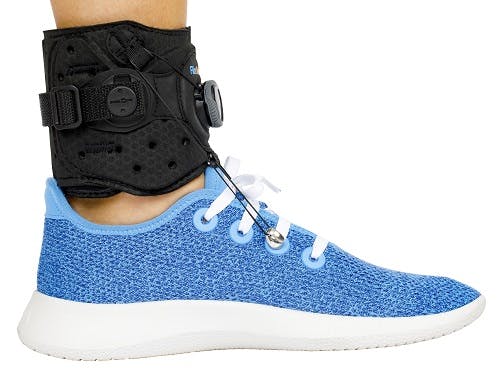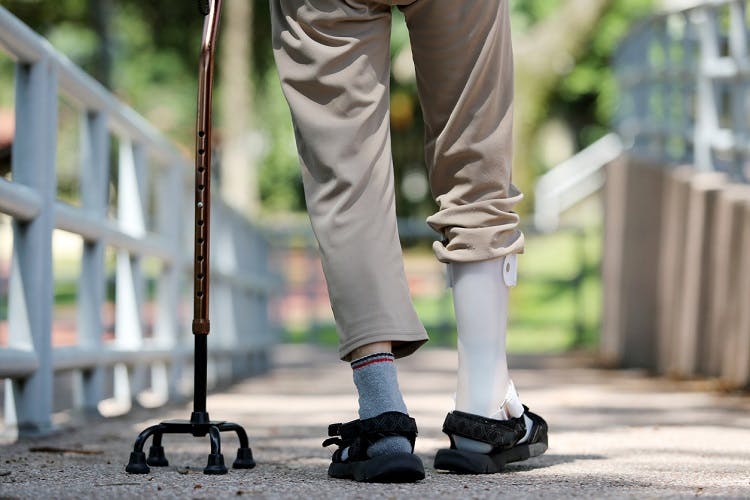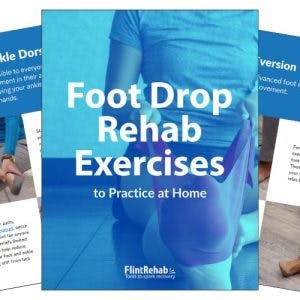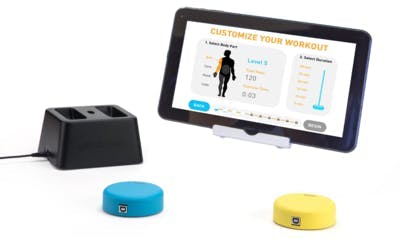Foot drop involves difficulty lifting the front portion of the foot, a movement known as dorsiflexion. Because this can make it difficult to walk and safely navigate around, therapists often recommend using an ankle foot orthotic, or an AFO brace for foot drop.
While an AFO is an excellent way to address foot drop, it is easy to become overly reliant on your brace. This can result in a slower recovery journey, or even cause further complications.
In this article, you’ll learn when it’s appropriate to use an AFO brace for foot drop and what to look for as you shop around.
Jump to a section:
Why Should You Use an AFO Brace for Foot Drop?
How a Foot Drop Brace Can Help Correct Poor Walking Patterns
What to Look for in an AFO Brace for Foot Drop
What Is the Best Brace for Foot Drop?
Drawbacks of Using a Foot Drop Brace Long-Term
How to Overcome Dependency on Foot Drop Braces
Why Should You Use an AFO Brace for Foot Drop?
Approximately 20% of stroke survivors experience foot drop. This condition involves difficulty with dorsiflexion, which can cause the foot to “drop” or drag when an individual is walking.
Typically, when individuals walk, the brain sends messages to various muscles to keeps the toes from dragging on the ground. When the communication between the brain and the muscles is disrupted, such as after a stroke or brain injury, foot drop can occur.
The inability to effectively lift the foot off the ground can be a significant safety concern. When the toes drag, it is easy to trip over items on the ground, such as a rug or crack in the sidewalk.
Furthermore, many individuals with foot drop also experience numbness in the affected foot. This means they may be unable to feel small changes when walking on uneven surfaces, increasing the possibility of a fall.
How a Foot Drop Brace Can Help Correct Poor Walking Patterns
Rather than letting their toes drag, some individuals with foot drop choose to swing their affected leg out to the side with each step to avoid dragging their toes. Others choose to lift their leg up high, like they are marching, to allow their foot to clear the ground.
However, these different walking patterns do not address the actual root cause of foot drop, nor are they likely to promote recovery. On the other hand, they are likely to cause further complications, such as chronic pain and faster rates of fatigue.
This is why doctors and therapists frequently suggest wearing an AFO brace for foot drop. AFO braces support the ankle, keeping the toes aligned with the rest of the foot, rather than allowing them to drag.
This increases your safety when walking and helps prevent the development of abnormal gait patterns. In turn, those who use a foot drop brace are able to move around more safely and easily.
What to Look for in an AFO Brace for Foot Drop
Your doctor or physical therapist is the best resource for choosing the perfect AFO. After all, every individual is different, which means that everyone will benefit from different types of foot drop braces.
In order to have a productive conversation with your therapist, it helps to be aware of the various characteristics that are available in AFO braces.
Here are some factors that should be considered when purchasing an AFO brace for foot drop:

- Rigid or soft. Rigid braces are more supportive, while softer braces are more comfortable and less likely to cause skin integrity issues. Flex AFO, pictured above, is a good example of a soft brace.
- Hinged or solid. Hinged braces allow individuals to continue using their ankle muscles, while solid braces fully support the foot and ankle and may result in ankle contractures (severe spasticity) when used for long periods of time.
- Custom-made or prefabricated. While custom-made options are personalized and adapted to your specific needs and body structure, prefabricated options may be more appropriate if you’ll be using it only short-term as you pursue a full recovery.
- Easily concealed or outwardly visible. Although this is not the most practical consideration, some individuals may feel strongly that they want their AFO brace to be as discreet as possible.
- Cost-effective or more expensive. Costs of AFOs vary greatly depending on your insurance coverage and the type of AFO needed.
While there are many AFO options available, one of the braces that we recommend you consider is the Flex AFO from Flint Rehab. This AFO brace for foot drop combines the benefits of a soft foot drop brace with cost-effectiveness and discreetness.
It works by attaching to your ankle and then, with the simple turn of a dial, lifts your foot into the optimum position to prevent foot drop. As you shop around for a foot drop brace of your own, keep these factors in mind and don’t be afraid to reach out to your therapist for recommendations.
What Is the Best Brace for Foot Drop?
Choosing the best brace for foot drop largely depends on your specific needs, lifestyle, and the guidance of your healthcare provider. However, there are several factors that can help you determine which AFO brace might be the most suitable.
Here are some things to consider when determining the “best” brace for your foot drop.
- Comfort and Fit: For daily use, it’s essential to have a brace that is both comfortable and doesn’t cause irritation or skin issues. Soft braces, like the Flex AFO, tend to be more comfortable for extended wear, while rigid braces offer more stability.
- Mobility and Flexibility: Some individuals with foot drop benefit from a hinged AFO, which allows for a bit more ankle movement and flexibility. Hinged designs enable you to continue using some of your ankle muscles, which can be helpful in preventing long-term stiffness or contractures. However, for those needing full support, a solid AFO may be more effective.
- Customization: Custom-made AFOs are ideal if you have unique needs or structural requirements, as they are molded to fit your foot and ankle precisely. While more costly, custom AFOs can provide a superior fit and accommodate specific needs. Prefabricated options, on the other hand, are generally more affordable and may work well for short-term use.
- Visibility: Some people prefer a more discreet AFO that can be concealed within shoes or clothing. If this is important to you, look for slimmer designs that are less noticeable and still provide the necessary support.
- Affordability: Cost is often a deciding factor, especially for long-term use. The price of AFOs can vary based on the material, customization level, and your insurance coverage. Cost-effective options like the Flex AFO provide essential support without a high price tag.
Some individuals may feel overwhelmed with the number of options. Talking with your physical therapist is an excellent way to gain clarity. They can provide personalized recommendations based on your needs and abilities. In addition, they may even have a few different types of AFOs to try out in the clinic. This can help you get a better idea of which style may be most effective.
Recommended AFO Brace for Foot Drop
One of the best braces available for foot drop is the Flex AFO from Flint Rehab. It’s a soft, affordable, and discreet option that allows you to easily adjust the level of support based on your needs. With the turn of a dial, the Flex AFO gently lifts your foot into the correct position, which helps prevent foot drop in addition to offering comfort and stability.
As individuals regain ankle control, they can gradually lower the level of support. This can allow them to use their ankle muscles as much as possible, promoting recovery while still providing support as needed.
In addition to all of the benefits above, there is also a 30 day money back guarantee where you can return the brace if you aren’t completely satisfied. You can learn more at https://www.flintrehab.com/product/afo/.
Drawbacks of Using a Foot Drop Brace Long-Term
Although AFO braces are a widely used treatment for foot drop, there are several disadvantages. AFOs can reduce air circulation around the foot and ankle, potentially leading to the development of wounds. This is especially common with rigid AFOs.
Some types of AFOs can also make it more difficult to feel the walking surface beneath the feet, causing challenges with balance. They also may be uncomfortable and not visually appealing. This is more common with large, bulky in-shoe AFOs that increase the amount of material between the bottom of your foot and the ground beneath you.
The most significant drawback is that while foot drop braces are an excellent way to compensate for the muscle weakness associated with foot drop, they do not promote a full recovery. Rather than rehabilitating the affected neural pathways that cause foot drop, AFO braces simply address the outward physical symptoms.
When individuals use an AFO brace for foot drop, their brain no longer needs to use the neural pathways associated with lifting the toes. Over a long period, these unused neural pathways become progressively weaker.
This can result in learned nonuse, where the brain notices that you are no longer using a function and decides it is no longer necessary to keep that skill. This is the origin of the popular phrase in neurological recovery: “use it or lose it!”
If you don’t use your ankle mobility, you’ll lose your ankle mobility.
How to Overcome Dependency on Foot Drop Braces
The goal of neurological recovery isn’t to find compensation techniques for everything. Rather, optimal recovery involves retraining the neural pathways and muscles to function appropriately.
This is achieved through neuroplasticity, the mechanism that your brain uses to rewire itself and form new neural connections. Neuroplasticity is activated through repetitive practice.
By repeating foot drop exercises frequently, neuroplasticity will start to engage and begin reconnecting your brain to your muscles. Physical therapists may also use functional electrical stimulation to promote better communication between your nerves and muscles.
Want 13 pages of foot drop exercises in a beautiful PDF? Click here to download our free Stroke Rehab Exercise ebook now (link opens a pop up for uninterrupted reading)
As your ankle and foot mobility gradually improves over time, you may be able to begin reducing time spent using your AFO. With your doctor or therapist’s approval, you may begin to practice walking without your AFO in a safe environment.
It may take time to fully recover your ability to walk properly and safely without your foot drop brace, but neuroplasticity makes it possible.
Should You Use an AFO Brace for Foot Drop?
AFO braces, such as the Flex AFO, are frequently one of the first treatments recommended for individuals with foot drop. However, for many, an AFO should be used as a temporary safety aid rather than a permanent treatment.
We encourage you to start practicing foot drop exercises on a regular basis, preferably with a full-body rehabilitation exercise regimen. This will optimize neuroplasticity and help you regain use of your ankle and foot. As you continue to improve, neuroplasticity can help you slowly start to outgrow the need for an AFO. And with enough time and effort, you might be able gradually wean off of your AFO altogether.
Foot drop can significantly impact your mobility and independence – but it doesn’t have to be a permanent setback. Our free eBook, “Your Ultimate Guide to Food Drop Exercises for Home,” is your step-by-step guide to real progress – Download our FREE eBook “Your Ultimate Guide to Food Drop Exercises for Home”!














